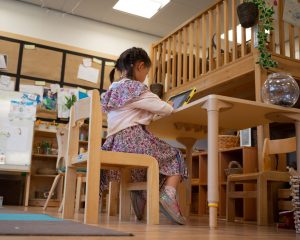By: Karissa Arce
Online learning, remote learning, home based learning, digital school… call it however you want, but the experience behind it, especially for a lot of parents, is not that pleasant. I think my phone has been 10x more active since online learning started. I have parents asking how to teach a certain topic OR how to teach their child in general. I got you, momma! Hang in there!
I know that different parent, different parenting styles but when it comes to teaching your children, we have to remember this mantra: this is about my child, how my child learns, and NOT me. (repeat to self until fade)
To be honest, when the pandemic started and we all suddenly switched to online classes, I thought I’d be giving a whole new advice to parents or that the concerns they will tell me will be different. But to my surprise, it’s the same.
“Ysa, can you give me more activity? Adrianna already finished the homework you gave her. I don’t want her to not do anything or else she will start bothering everyone in the house.”
“Hi Ysa! Is it okay if we submit the show and tell the video late? We forgot to prepare Charis’ lines.”
“I don’t know how you are able to be patient. We’ve been sitting for an hour already doing the pattern activity and Rocco still cannot get it. I am losing my mind.”
*Sends me a video of their child crying out of frustration* “Do you also accept crying mum?”
“Hi Ysa! Super thank you for making the workload light for us mums! Please keep it that way! ☺”
Yup, some are okay, some are getting frustrated, some are asking for extra work, and some are taking their time. This is basically how my class was pre pandemic as well. The only difference I see is that the parents are the one expected to do more work/hands on with their children and give us feedback or observation on how their child responded. (I rarely get feedback about the child. I get more feedback on how the parents either enjoyed doing the activity or how it made them frustrated because their child took longer.)
So let me share to you some tips that I tell my parents to help them keep up with the “new normal” way of learning:
1. Establish routines
When you establish routines, it will help you manage your child’s daily activities. This will also feel like they are in school. Make a visible schedule chart for them to see to help them track what is going to happen in the day. Eventually when they are used to it, they will transition from one task to another smoothly. Remember: consistency is the key. You have to also follow the schedule you made by heart to help your child cope up with it as well. Don’t forget to also talk to your child when you make the schedule – Include them with the planning. Set and communicate expectations and boundaries to help your child have an idea on the things they can do. Say 10 – 10:30 is snack time. What can your child do while they are on break? Are they allowed to watch? Can they play with their toys? Can they take a nap? How can they spend their 30 minutes of break time that will be beneficial for them and for you as their parents who are also busy with other things?
2. Set a learning pace
Remember the mantra I taught you earlier? You will need it here.
I understand that we all have our own pace when it comes to learning. Some can work fast and some will take their time in finishing a given task. I had a class before of 20 students. 20 different individuals that I have to handle from Mondays to Fridays. They all have their own way of doing things, they all have their own pace when it comes to completing tasks. Even if I have 2 support teachers, it did not turn into a walk in the park that easily – because I also have to consider how these two adults work in certain situations. How did I manage to make it as coordinated as possible? By keeping that mantra in mind and being observant.
I work pretty fast and I would like it if the people around me would do the same. HOWEVER, that is not possible. When I work with children, I make sure to observe how they respond to different tasks. Forcing children to match your speed or expectations will result in frustration on both sides. If possible, delegate the work throughout the session instead of asking them to finish everything at once. If I can see that the child is getting overwhelmed or is simply not in the mood, I will not make them work so much on the assigned task BUT I will give them something else to do first to help them release that feeling and then we will resume getting back on track.
“I can see that you are not yet ready to work in our Maths centre. I’ll give you 5 minutes to stay in the construction centre then we will continue with this after, okay?”
“Aaron, we will answer until the number 5 on your worksheet. (after number 5) Do you think you can answer some more? No? That’s alright. We will continue the rest later. Thank you for accomplishing until number 5.”
When you set the pace, you also have to remember to set your boundaries to them. This will help them understand that there are things that they need to accomplish on time or because they have been prolonging the activity and you don’t want them to develop that habit.
“Maya, I need you to read your ORT book with me today because we have to return it to school tomorrow.”
“Hailey, I noticed that you haven’t started working on your show and tell presentation. Your schedule is on Friday and it’s already Wednesday. I would really appreciate it if you started practicing what your lines are so you will be ready by Friday. I can help you practice your lines with you if you want. “
Keep in mind that when setting the pace, your focus should be on results that will help the child develop positive study habits based on their skills and pace.
“This is about my child, how my child learns, and not me” (repeat to self until fade)
3. Make good use of their 5 senses
I always keep this in mind whenever I plan my activities – children will learn best if they use their senses. They learn best when they can see, taste, hear, smell or even touch. When their senses are being utilized, they will be able to process information faster and the comprehension will also develop.
Say you are learning about numbers. Typically, you will show them printed numbers and they will memorize it. But what does that number mean? I usually suggest counting in their daily activity. Here are some examples:
How many spoons full of water do we need to fill up this small cup?
How many steps would it take from your bed to the door?
Can you help me get 3 apples on the shelf?
You can get 5 different toys at a time but be sure to put them back when you are done using
Involving concepts in their daily activities will help them understand the connection of what they are learning to real life settings. This will help strengthen their memory because they are able to apply and experience first-hand. Try not to worry about whether they are doing it flawlessly. Remember: Focus on the process rather than the outcome. The more exposure or chances they are given to practice what they are learning, the more they will gain understanding. They will also improve the execution in the process.
So don’t be afraid to be creative. Learning can happen at any given time of the day. Sometimes on purpose and sometimes by chance. Involve them in food preparation, house cleaning, grocery shopping and other activities where they can see the connection of what they are learning to the real world. Let their 5 senses work their magic!
4. Establishing the rules TOGETHER
This is something that I have always stressed on to parents – creating boundaries or rules together with their children.
When you set your expectations and you communicate them to your child, you are teaching them how to be responsible and how to be mindful. It is ideal to set goals together so that you both can exchange ideas on what will work best. Involving your child with the decision making will help you gain an idea if the expectations you are setting are just right or you need to make some adjustments.
Instead of:
“Ruby, when we are eating, I want you to finish everything on your plate.”
Try this:
“When you are full and you still have a lot of food left on your plate, can you please let me know?”
There are some moments when the boundaries you both set are broken. I highly encourage you to process this to your child by explaining to them what boundary was broken and why it’s important that it is not disregarded. Rather than just getting mad and saying less words. Children need explanation as much as possible to help them understand better how things are connected.
Instead of:
Why are you just sitting there and not eating? It’s lunch time. You are supposed to eat. Finish your food.
Try saying this:
Hey, you’ve been sitting there for a while and you’re not touching your food anymore. Do you remember what we talked about before? If you are not going to use your words, I won’t be able to understand what you need. Like right now. Can you try to use your words next time and tell me when you are already full? I really want you to do that. Thank you.
5. Give yourself room to breathe
Don’t forget to give yourself a break time as well! When you feel that it’s getting too much, you ask someone to take over for a bit so you can collect your sanity back. Just like your children, when you are getting burned out or overwhelmed, it is best to step back and not push yourself too much. I strongly advise that you also give yourself some sort of reward for surviving the day/week/month! After all, we are all trying our best to cope with the changes. We need to recognize our efforts and our patience.
(During the first few weeks of online teaching, we were all going crazy because it was so sudden, and all the preparation that we made before starting the term were revised and had to be updated as quickly as possible. After the stressful weeks, I bought me a bottle of wine, ordered chicken nuggets, put on my comfy pj’s, turned on Netflix and watched FRIENDS, and my weekend was a done deal. Best reward I could give myself during the beginning of lockdown and online learning journey.)
This “new normal” might not be as ideal as we want it to be. Personally, I don’t enjoy spending time with children through the screen. I miss having random conversations and out of the blue comments that usually catches me off guard. But this is better than worrying for safety especially during this period. While I know this can be challenging to parents, keep in mind that this is also a good opportunity to spend time and get to know your child – To learn more about the person they are becoming. I hope these tips will be helpful to you. And if you are in need of guidance, you can always reach out to your child’s teacher for more ideas or even to other moms and exchange notes! You got this!
About the author:
Karissa Arce is a preschool teacher with a degree in Early Childhood Education and have been teaching for more than a decade. Her experience of working abroad helped her understand better how to be an effective teacher inside and outside the classroom.




